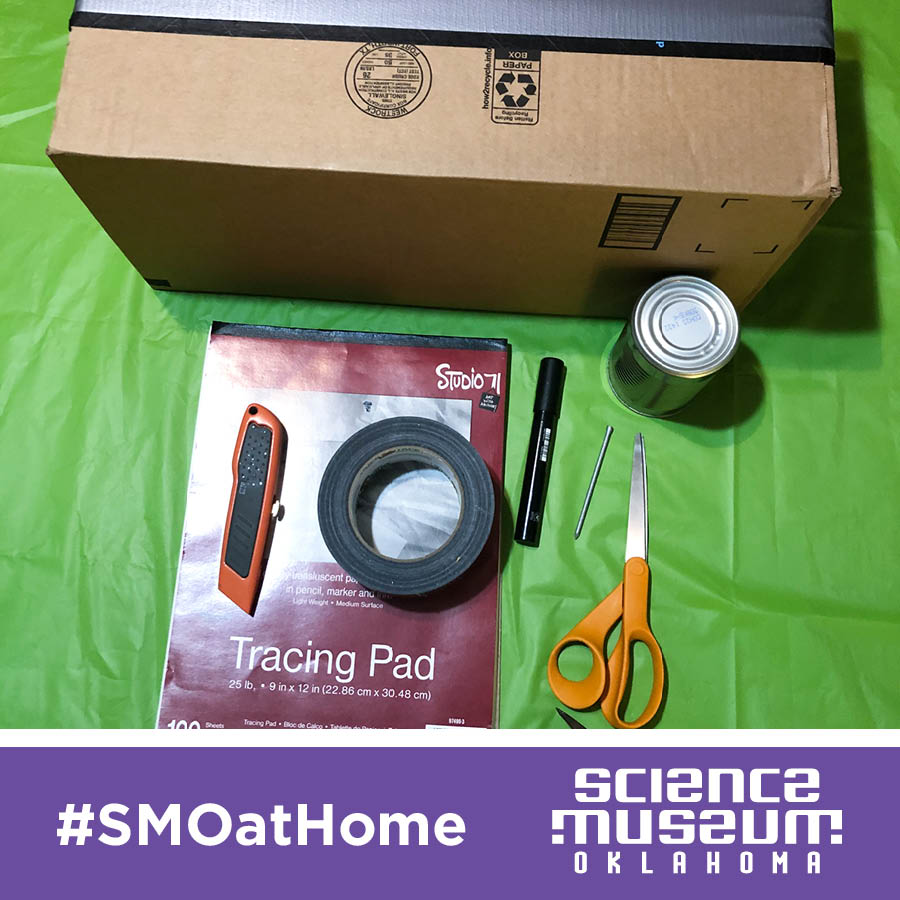Try This: Make a Camera Obscura
We tend to take cameras for granted now — they’re part of phones and even some doorbells! The word camera comes from an old Latin term, camera obscura, which means “dark chamber.”
When we think of the camera it can be considered as something that was developed rather than invented. The first photograph-producing camera that we associate with film was developed about 200 years ago. The first digital camera was developed less than 50 years ago and didn’t offer the type of crisp, clear images that we see today. Camera obscuras, however, go much, much further to about 2,500 years ago where scholars in China, Egypt, and Greece used camera obscuras to study light.

Camera obscuras can be any size, and you can turn a whole room into a camera obscura as long as it has a window that receives sunlight and it can be darkened. If that's not possible for you, skip down for a how-to on a camera obscura you can take outside. Get ready to see the world from a whole new perspective!
Here’s what to do:
1. Wait for a sunny time of day. The brighter it is outside, the better this will work.
2. Cover the windows so no sunlight can come in. If you have cardboard and tape or black plastic, these supplies are good resources for blocking out the sun’s light.
3. If the wall across from the window is white, or of a light color, just remove everything from the wall. If the wall is not a light color, you may want to cover it with a light colored sheet or white paper.
4. Cut a hole in the cardboard or black plastic covering the window to allow light in. The hole should be smaller than 1cm wide, so a hole about the width of a pencil is perfect.
5. If any light is entering the room from the doorway or other places, use t-shirts or towels to block out the light.
6. With your back to the window, look at the opposite wall. Allow your eyes to adjust to the dark. What do you see?
What’s happening:
The room has become a camera obscura, or dark chamber. Light rays travel in straight lines until they hit something. This can be difficult to observe in many settings. In this case, light from the sun bounces off objects outside, travels through the hole, into the room, hits the wall, then bounces off the wall into your eye. Light coming into the room that is bouncing off objects outside must pass through the hole in a straight line. As a result of this, top has become bottom, and bottom has become top on your wall. The image of the outdoors has flipped upside-down.
If your room is not completely dark, or if it is not very sunny outdoors, your image may appear blurry.
If you’re unable to turn an entire room into a camera obscura, you can make a simple yet very effective one with a few objects that you can likely find in your home.
Here’s what you need:
- Cardboard box, bigger than a shoebox
- Thin white paper, like tissue paper or tracing paper
- Empty tin can, like one that might’ve held beans or soup
- Hammer
- Nail
- Rubber band
- Sharp scissors
- Duct tape
- Marker
Here’s what to do:
1. Center the tin can on the short end of the box. Trace the end of the can. Cut the circular shape out.
2. Use the hammer and nail to puncture a hole in the center of the bottom of the tin can.
3. Use the thin white paper to cover the open end of the can. Hold the paper tightly in place with a rubber band. Then secure it in place with duct tape.
4. On the opposite end of the box, cut a shape similar to a short but wide “u.” This will be the viewing area.
5. Place the can through the hole. The half with the paper should be inside the box. The half with the punctured hole should be on the outside of the box.
6. Close the box and tape generously. Make sure that light can only enter the box through the punctured hole and viewing area.
Once your box is light-tight, take it outdoors and look at the world around you. Let your eyes adjust for best results. If you’re wearing a hoodie or a ball cap, you can use these to further block out the light and make the image clearer.





